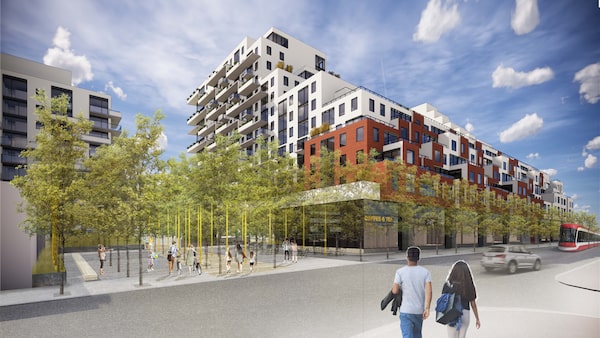
Rendering of the Queen-Coxwell Revitalization Project, designed by Teeple Architects and PUBLIC CITY.Toronto Community Housing/City of Toronto
Everyone agrees that Toronto is in a housing crisis. But what is the city going to do about it?
When it comes to political speeches, there’s a consensus. We need more housing, and quickly. But when the city has the chance to build more affordable housing on its own land, it lacks the boldness to build enough.
The latest evidence is the redevelopment of the Don Summerville apartments in Leslieville. These two buildings at Queen Street and Coxwell Avenue were built as social housing in the late 1960s – brown-brick slabs in a no man’s land of lawn and parking lots. They’re being replaced by a new mixed-income development that is in many ways admirable.
But it’s not as big as it should be. That’s because city projects are being shaped by old ideas about built form and “neighbourhood character.” The central impulse is that new buildings should be as unobtrusive as possible.
This stems from a mix of classism and muddled design thinking. In truth, either tall buildings or short buildings can make a good street. More density makes a better city. Yet the ethos of smaller-is-better prevails. It has hobbled the city’s Housing Now projects.
The Queen Street project, by Toronto Community Housing Corp., does attempt to push back. If approved, it would replace the existing 120 rent-geared-to-income affordable apartments on the site, and add to them 100 new affordable rental units, plus 530 condo and rental apartments, plus retail.
Its designers, Teeple Architects, have packed most of these into a U-shaped structure that starts low, at Queen Street, and then steps up and away to the south, topping out at 17 storeys overlooking green space and the lake. A park and courtyard by Liz Wreford and Public City promise to be both interesting and beautiful. It’s a solid piece of architecture and landscape.
It’s also very complicated, thanks to planning policy. All this twisting lets the building limbo an imaginary line that slants upward from Queen Street, what planners call an “angular plane.” The idea is to keep the building’s shadows away from Queen Street, which city planning views as a place with “small-town charm.”
Toronto, however, is not a small town. It’s a city of nearly three million that will likely hit four million within a generation. So why isn’t this open three-acre site, near downtown, a good place for much taller buildings? Why not house 100 more families here? Or 500?
Vincent Tong, TCHC’s director of development, expressed pride in the building’s “unique” design in an interview this week. But “we’ve been sensitive to the regulatory context,” he added. “Nothing in this area is over five storeys, and I think we’ve done a good job with a building that will blend into the community and not overwhelm it.”
That shouldn’t be something Mr. Tong has to worry about. And yet it is. TCHC and its private development partner, Context Development, have to deal with the design expectations of both city planning and the local councillor, Paula Fletcher.
They’re pushing, but not far enough. The best thing Toronto can do to attack its housing crisis is to build much more housing, as affordable as possible, and near transit as much as possible. Why not here?
“Could you add more? Well, I think you could,” says Howard Cohen, the president of Context Development. He had an earlier career as a senior Toronto city planner in the 1970s. In technical terms – its access to public transit, the sewer capacity – the site would support a larger number of people, he says.
“The question is: At what point do people feel overwhelmed by towers?” he asks. “This is a low-rise neighbourhood."
People don’t like to see towers built, he says. "But maybe in a housing crisis, you need to do more of that.”
This means cutting through the kudzu of the city’s planning policies and enforcing a new idea: that bigger is better. Housing, especially affordable housing, is worth sacrificing some “small-town charm.” The city should retain small storefronts, which provide that “charm,” and pack in lots of housing behind it.
For her part, Ms. Fletcher is rightly proud of the mix of housing at Queen and Coxwell. But “the heights are getting up there,” she says. “It’ll look very different from anywhere else in the east end.” Does this matter? “You do want to have something that looks good,” she says. “Queen Street has its own rhythm, and Queen is an important street.”
But what exactly does all that mean? Who decides what “looks good,” and on what basis? Do the people on TCHC’s waiting list, whose potential new homes are in the balance, get a say? Architectural quality and neighbourhood character are hard to define. But the stakes are high. The buildings shouldn’t be short.
 Alex Bozikovic
Alex Bozikovic